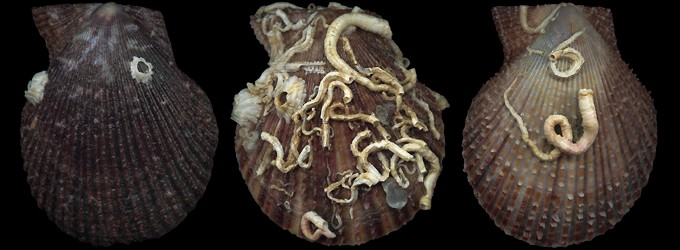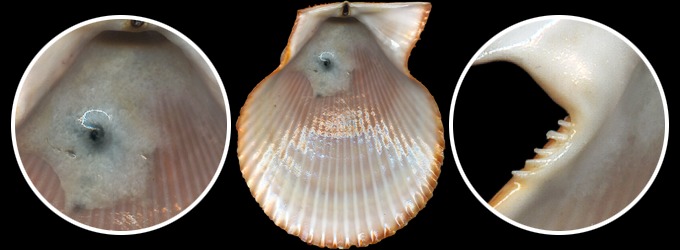Beautiful Mimachlamys varia (Linnaeus, 1758)
along the French shores

Mimachlamys varia is a locally common shell, which lives mainly in shallow water down to moderate depths, attached to the substract by its byssus. Medium-sized, it range from 45/50mm (average) to 80mm.
As this animal has the practice to live in crevices or under stones and rocks, it is much less often collected than free swimming species, like Aequipecten opercularis (Linnaeus, 1758). Thus, it could be more common than one believes, if we remember that the boats which collect the species don't like to dredge on bottoms strewn with rocks or wrecks.
It sometimes happens that a population is dredged, when its members live on flatter grounds than usual, for example on sand & gravel amidst aggregates of edible shells. It is the case of the first population which we will observe in these pages.
But most of the time, the shells which one finds are those who live in the intertidal area, deeply encrusted in oyster accumulations, in crevices or under rocks.
The distribution ranges from Norway south to Mauritania, Mediterranean, Red Sea (antilessepsian).
In the following pages, we have pictured some shells from southern Brittany, from western & southern France, Morocco, Malta and NE. Ireland.
As this animal has the practice to live in crevices or under stones and rocks, it is much less often collected than free swimming species, like Aequipecten opercularis (Linnaeus, 1758). Thus, it could be more common than one believes, if we remember that the boats which collect the species don't like to dredge on bottoms strewn with rocks or wrecks.
It sometimes happens that a population is dredged, when its members live on flatter grounds than usual, for example on sand & gravel amidst aggregates of edible shells. It is the case of the first population which we will observe in these pages.
But most of the time, the shells which one finds are those who live in the intertidal area, deeply encrusted in oyster accumulations, in crevices or under rocks.
The distribution ranges from Norway south to Mauritania, Mediterranean, Red Sea (antilessepsian).
In the following pages, we have pictured some shells from southern Brittany, from western & southern France, Morocco, Malta and NE. Ireland.
Variations:
With or without spatulate spines.
My humble experience lets me believe that the spatulae are present in shells living on subtidal flat bottoms, while shells living intertidally in crevices are deprived of well developed spines.
In Brittany, the shells are called "Black Scallops", because most of them are extremely dark (this is the form "atra" Locard, 1888: close to jet black).
Nevertheless, M. varia is known to raise some other colours:
aurantia (Clement, 1879) is yellow-orange
rubra (Scacchi, 1836) is bright red
purpurea (Jeffreys, 1864) is violet
Moreover, some shells tend to amelanism, with a soft transition between dark and white specimens.
Mimachlamys nivea (Macgillivray, 1825) is a geographical subspecies living in northern Europa, at least along the western coast of Scotland (see Janice M. Light, journal of conchology, vol.33, n°1, 1988).
The average shell is brown and spotted with paler dots, especially near the umbos.
It has been discussed (see opercularis pages, november 2003 issue) that the presence of a pattern could be connected with a behaviour of camouflage, always vital for youthful.
My humble experience lets me believe that the spatulae are present in shells living on subtidal flat bottoms, while shells living intertidally in crevices are deprived of well developed spines.
In Brittany, the shells are called "Black Scallops", because most of them are extremely dark (this is the form "atra" Locard, 1888: close to jet black).
Nevertheless, M. varia is known to raise some other colours:
aurantia (Clement, 1879) is yellow-orange
rubra (Scacchi, 1836) is bright red
purpurea (Jeffreys, 1864) is violet
Moreover, some shells tend to amelanism, with a soft transition between dark and white specimens.
Mimachlamys nivea (Macgillivray, 1825) is a geographical subspecies living in northern Europa, at least along the western coast of Scotland (see Janice M. Light, journal of conchology, vol.33, n°1, 1988).
The average shell is brown and spotted with paler dots, especially near the umbos.
It has been discussed (see opercularis pages, november 2003 issue) that the presence of a pattern could be connected with a behaviour of camouflage, always vital for youthful.

A cyst in the upper valve of an orange adult (51mm).
Notice the fine indentations which border the lower valve, near the byssal notch: this comb separates the byssal threads. According to Waller (1984), this could prevent the shell from twisting.
This ctenolium has given its name to the family PECTINIDAE.
Localities:
The samples shown in the following pages come from three distinct areas of the french shores, with an interesting contribution made by Stanley Francis who collected Mimachlamys varia in northern Ireland.
Notice the fine indentations which border the lower valve, near the byssal notch: this comb separates the byssal threads. According to Waller (1984), this could prevent the shell from twisting.
This ctenolium has given its name to the family PECTINIDAE.
Localities:
The samples shown in the following pages come from three distinct areas of the french shores, with an interesting contribution made by Stanley Francis who collected Mimachlamys varia in northern Ireland.